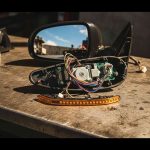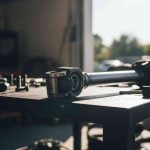Understanding Modern Side Mirror Technology
Modern vehicle side mirrors have evolved far beyond simple reflective glass. Today’s mirrors are sophisticated assemblies packed with electronic features that require careful matching when sourcing replacement parts from junkyards near me. Understanding these features is crucial for successful replacement.
When shopping for a replacement side mirror at a salvage yard, you’re not just looking for a piece of glass and housing. You need to match your vehicle’s exact feature set, including power adjustments, heating elements, turn signal indicators, puddle lights, and advanced safety systems like blind spot monitoring.
Essential Features to Identify in Side Mirrors
Before heading to any salvage yard, create a comprehensive list of your current mirror’s features. This preparation will save time and ensure compatibility with your vehicle’s electrical system.
- Power Adjust Motors: Electronic positioning controlled from inside the vehicle
- Heated Elements: Built-in defrosting capability for cold weather visibility
- Turn Signal Integration: Amber or clear lighting that syncs with directional signals
- Puddle Lighting: Ground illumination when doors are unlocked or opened
- Blind Spot Detection (BLIS): Advanced warning systems with visual indicators
Visual Identification Guide for Donor Mirrors
Learning to quickly identify mirror features at the junkyard is essential for efficient shopping. Each feature leaves distinct visual clues that experienced salvage yard shoppers can spot immediately.
| Feature | Visual Identification Clues |
|---|---|
| Power Adjust | Multi-wire connector harness at mounting point |
| Heated Glass | Two small metal terminals on mirror glass backing |
| Turn Signals | Clear or amber lens molded into housing side |
| Puddle Lights | Separate light assembly on bottom housing surface |
| Blind Spot Detection | Specialized connector or visible sensor area on glass |
The wiring harness and connector plug on the donor mirror must exactly match your vehicle’s connector for all electronic features to function properly.
Testing Power Functions Before Purchase
Smart junkyard shoppers always test electronic functions before purchasing. With a portable power source, you can verify that expensive motor assemblies work properly, potentially saving hundreds of dollars on faulty parts.
Testing Power Adjustment Motors
- Identify Wire Configuration: Locate common wire (typically yellow) and directional control wires
- Apply Test Voltage: Use 9-volt or 12-volt battery with proper polarity
- Check Movement: Test both horizontal and vertical adjustment directions
- Listen for Problems: Humming without movement indicates motor failure
- Reverse Polarity: Switch connections to test opposite directions
For more advanced testing, some experienced buyers temporarily connect the donor mirror to their vehicle’s switch harness. This method uses the car’s own controls while holding the mirror assembly, providing the most accurate functional test possible.
Verifying Heating and Lighting Systems
Heating elements can be tested using a multimeter for continuity, or by applying 12 volts across the heating terminals and checking for warmth generation. Turn signals and puddle lights require connecting appropriate harness wires to power sources to verify illumination functionality.
Comprehensive Physical Inspection Checklist
A thorough visual inspection prevents purchasing damaged assemblies that could fail after installation. This systematic approach helps identify potential problems before money changes hands.
| Inspection Area | Check Points | Failure Indicators |
|---|---|---|
| Mirror Glass | Cracks, chips, delamination | Shattered glass, loose backing |
| Housing Shell | Structural integrity, mounting points | Deep cracks, missing pieces |
| Mounting Base | Bolt holes, attachment points | Stripped threads, broken tabs |
| Electrical Connector | Locking tabs, pin condition | Corroded pins, cracked housing |
| Overall Stability | Assembly tightness, vibration | Excessive movement, rattling |
Smart Shopping Strategies for Mirror Assemblies
Successful junkyard shopping requires strategy and preparation. Understanding inventory cycles, seasonal patterns, and proper removal techniques can significantly improve your chances of finding quality parts.
When removing mirror glass, exercise extreme caution to prevent cracking. If the housing shows damage but contains all necessary electronic features with solid mounting points, it may still be worth purchasing, as loose housings can often be repaired or reinforced.
Matching Vehicle Specifications
Vehicle compatibility extends beyond make, model, and year. Trim levels, option packages, and regional variations can affect mirror specifications. Research methodologies for identifying compatible parts have evolved, making it easier to find exact matches.
- VIN Decoding: Use vehicle identification numbers to verify specific options
- Option Codes: Check door jamb stickers for factory-installed features
- Trim Level Verification: Confirm your vehicle’s exact specification level
- Regional Differences: Account for market-specific feature variations
Installation Preparation and Compatibility
Before installation, verify that all connectors match perfectly. Mismatched wiring can damage vehicle electrical systems or prevent proper mirror function. Modern vehicles often require specialized knowledge for proper integration of electronic systems.
Some advanced features like blind spot monitoring may require calibration after installation. Research your specific vehicle’s requirements before beginning the replacement process to avoid complications or additional costs.
Cost-Saving Benefits of Junkyard Mirrors
Purchasing side mirrors from salvage yards can save 50-80% compared to dealer prices. Quality OEM mirrors from reputable yards often provide better value than aftermarket alternatives while maintaining original equipment specifications.
When you’re ready to sell your junk car for cash, remember that vehicles with intact mirror assemblies typically bring higher scrap values, making proper maintenance and timely repairs financially beneficial.
Environmental Benefits of Used Parts
Choosing used mirrors supports automotive recycling efforts and reduces manufacturing demand for new parts. This environmentally conscious approach helps minimize waste while providing reliable, tested parts at affordable prices.
Modern research and evaluation methods have shown that properly maintained used auto parts can provide service life comparable to new parts while significantly reducing environmental impact through reduced manufacturing and shipping requirements.
Final Inspection Before Purchase
Before completing your purchase, perform a final comprehensive check. Ensure all identified features match your requirements, electrical connections are clean and secure, and mounting points show no signs of stress or damage.
Take photos of the donor mirror’s connections and mounting configuration. These images will prove invaluable during installation and help verify proper reassembly of all electrical connections and mounting hardware.
Remember that investing time in proper selection and inspection at the junkyard prevents frustration, additional costs, and safety concerns later. A quality used side mirror assembly, properly selected and installed, can provide years of reliable service while maintaining your vehicle’s safety and functionality.





Leave a Reply
You must be logged in to post a comment.